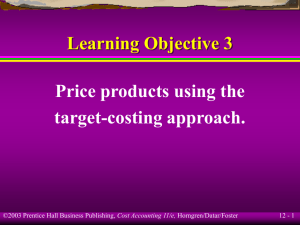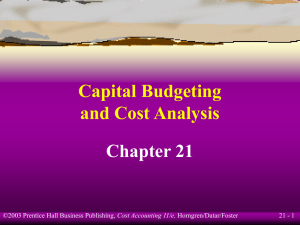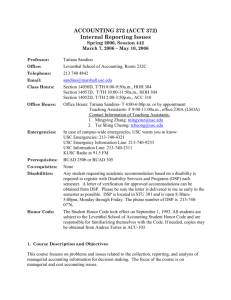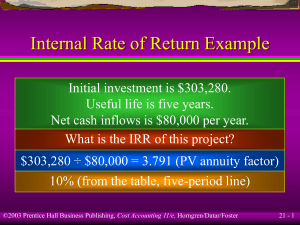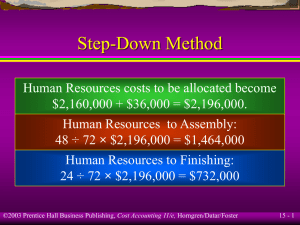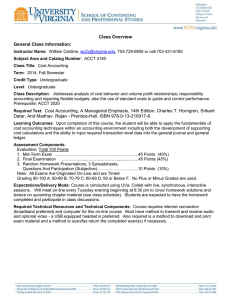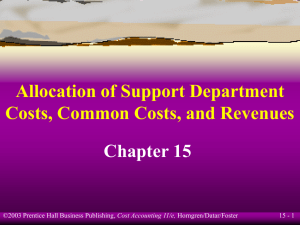Strategy, Balanced Scorecard, and Strategic Profitability Analysis Chapter 13 13 - 1
advertisement
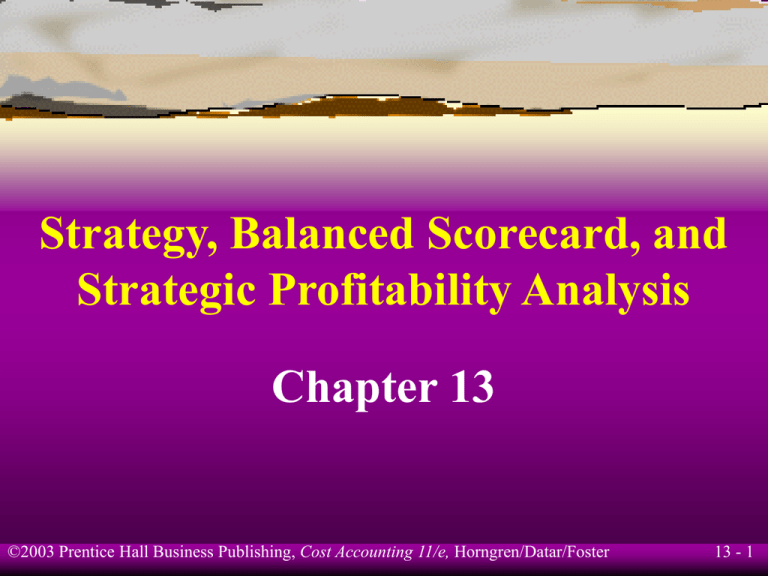
Strategy, Balanced Scorecard, and Strategic Profitability Analysis Chapter 13 ©2003 Prentice Hall Business Publishing, Cost Accounting 11/e, Horngren/Datar/Foster 13 - 1 Learning Objective 1 Recognize which of two generic strategies a company is using. ©2003 Prentice Hall Business Publishing, Cost Accounting 11/e, Horngren/Datar/Foster 13 - 2 What is Strategy? Strategy describes how an organization matches its own capabilities with the opportunities in the marketplace to accomplish its overall objectives. ©2003 Prentice Hall Business Publishing, Cost Accounting 11/e, Horngren/Datar/Foster 13 - 3 What is Strategy? What is the focus of industry analysis? Competitors Potential entrants into the market Equivalent products Bargaining power of customers Bargaining power of input suppliers ©2003 Prentice Hall Business Publishing, Cost Accounting 11/e, Horngren/Datar/Foster 13 - 4 Basic Strategies 1. Product differentiation 2. Cost leadership ©2003 Prentice Hall Business Publishing, Cost Accounting 11/e, Horngren/Datar/Foster 13 - 5 Implementation of Strategy Management accountants design reports to help managers track progress in implementing strategy. ©2003 Prentice Hall Business Publishing, Cost Accounting 11/e, Horngren/Datar/Foster 13 - 6 The Balanced Scorecard The scorecard measures an organization’s performance from four perspectives: 1. Financial 2. Customer 3. Internal business processes 4. Learning and growth ©2003 Prentice Hall Business Publishing, Cost Accounting 11/e, Horngren/Datar/Foster 13 - 7 Learning Objective 2 Identify what comprises reengineering. ©2003 Prentice Hall Business Publishing, Cost Accounting 11/e, Horngren/Datar/Foster 13 - 8 Reengineering Reengineering is the fundamental rethinking of business processes delivery to achieve improvements in critical measures of performance such as cost, quality, service, speed, and customer satisfaction. ©2003 Prentice Hall Business Publishing, Cost Accounting 11/e, Horngren/Datar/Foster 13 - 9 Reengineering Example Dallas Co. order delivery system: Customers needs identified Quantities to be shipped matched against purchase order Purchase order issued Production scheduled Shipping documents sent to Billing Department Manufacturing completed Invoice issued Finished goods to inventory Customer payment follow up ©2003 Prentice Hall Business Publishing, Cost Accounting 11/e, Horngren/Datar/Foster 13 - 10 Reengineering Example The following was determined: Frequently, there is a long waiting time before production begins in the manufacturing department. Sometimes items are held in inventory until a truck is available for shipment. ©2003 Prentice Hall Business Publishing, Cost Accounting 11/e, Horngren/Datar/Foster 13 - 11 Reengineering Example If the quantity shipped does not match the number of items requested by the customer, a special shipment must be scheduled. Dallas discovered that the many transfers across departments slowed down the process and created delays. A multifunctional team reengineered the order delivery process. ©2003 Prentice Hall Business Publishing, Cost Accounting 11/e, Horngren/Datar/Foster 13 - 12 Reengineering Example A customer relationship manager is responsible for each customer. Dallas will enter into long-term contracts with customers specifying quantities and prices. The customer relationship manager will work with the customer and manufacturing to specify delivery schedules one month in advance. ©2003 Prentice Hall Business Publishing, Cost Accounting 11/e, Horngren/Datar/Foster 13 - 13 Reengineering Example The schedule of customer orders will be sent electronically to manufacturing. Completed items will be shipped directly from the manufacturing plant to customer sites. Each shipment will automatically trigger an invoice to be sent electronically to the customer. ©2003 Prentice Hall Business Publishing, Cost Accounting 11/e, Horngren/Datar/Foster 13 - 14 Learning Objective 3 Present the four perspectives of the balanced scorecard. ©2003 Prentice Hall Business Publishing, Cost Accounting 11/e, Horngren/Datar/Foster 13 - 15 Perspectives of Performance 1. Financial 2. Customer 3. Internal business process 4. Learning and growth ©2003 Prentice Hall Business Publishing, Cost Accounting 11/e, Horngren/Datar/Foster 13 - 16 Financial Perspective Objective: Increase shareholder value Measures: Increase in operating income ©2003 Prentice Hall Business Publishing, Cost Accounting 11/e, Horngren/Datar/Foster 13 - 17 Financial Perspective Initiatives: Manage costs and unused capacity Build strong customer relationships Build strong customer relationships Target Actual Performance Performance $2,000,000 $2,100,000 $3,000,000 $3,420,000 6% 6.48% ©2003 Prentice Hall Business Publishing, Cost Accounting 11/e, Horngren/Datar/Foster 13 - 18 Customer Perspective Objectives: Increase market share Increase customer satisfaction Measures: Market share in communication networks segment Customer satisfaction survey ©2003 Prentice Hall Business Publishing, Cost Accounting 11/e, Horngren/Datar/Foster 13 - 19 Customer Perspective Initiatives: Target Actual Performance Performance Identify future needs 6% 7% of customer Identify new target 7 8 customer segments Increase customer focus 90% give top 87% give top of sales organization two ratings two ratings ©2003 Prentice Hall Business Publishing, Cost Accounting 11/e, Horngren/Datar/Foster 13 - 20 Internal Business Process Perspective Objectives: Improve manufacturing quality and productivity Meet specified delivery dates Measures: Yield On-time delivery ©2003 Prentice Hall Business Publishing, Cost Accounting 11/e, Horngren/Datar/Foster 13 - 21 Internal Business Process Perspective Initiatives: Identify problems and improve quality Reengineer order delivery process Target Actual Performance Performance 78% 79.3% 92% 90% ©2003 Prentice Hall Business Publishing, Cost Accounting 11/e, Horngren/Datar/Foster 13 - 22 Learning and Growth Perspective Objectives: Align employee and organization goals Improve manufacturing processes Measures: Employee satisfaction survey Improvements in process controls ©2003 Prentice Hall Business Publishing, Cost Accounting 11/e, Horngren/Datar/Foster 13 - 23 Learning and Growth Perspective Initiatives: Employee participation and suggestion program to build teamwork Organize R&D/ manufacturing teams to modify processes Target Actual Performance Performance 80% of 88% of employees employees give top give top two ratings two ratings 5 ©2003 Prentice Hall Business Publishing, Cost Accounting 11/e, Horngren/Datar/Foster 5 13 - 24 Aligning the Balanced Scorecard to Strategy Different strategies call for different scorecards. What are some of the financial perspective measures? Operating income Revenue growth Cost reduction is some areas Return on investment ©2003 Prentice Hall Business Publishing, Cost Accounting 11/e, Horngren/Datar/Foster 13 - 25 Aligning the Balanced Scorecard to Strategy What are some of the customer perspective measures? Market share Customer satisfaction Customer retention percentage Time taken to fulfill customers requests ©2003 Prentice Hall Business Publishing, Cost Accounting 11/e, Horngren/Datar/Foster 13 - 26 Aligning the Balanced Scorecard to Strategy What are some of the internal business perspective measures? Innovation Process: Manufacturing capabilities Number of new products or services New product development time Number of new patents ©2003 Prentice Hall Business Publishing, Cost Accounting 11/e, Horngren/Datar/Foster 13 - 27 Aligning the Balanced Scorecard to Strategy Operations Process: Yield Defect rates Time taken to deliver product to customers Percentage of on-time delivery Setup time Manufacturing downtime ©2003 Prentice Hall Business Publishing, Cost Accounting 11/e, Horngren/Datar/Foster 13 - 28 Aligning the Balanced Scorecard to Strategy Post-sales service: Time taken to replace or repair defective products Hours of customer training for using the product ©2003 Prentice Hall Business Publishing, Cost Accounting 11/e, Horngren/Datar/Foster 13 - 29 Aligning the Balanced Scorecard to Strategy What are some of the learning and growth perspective measures? Employee education and skill level Employee satisfaction scores Employee turnover rates Information system availability Percentage of processes with advanced controls ©2003 Prentice Hall Business Publishing, Cost Accounting 11/e, Horngren/Datar/Foster 13 - 30 Pitfalls When Implementing a Balanced Scorecard What pitfalls should be avoided when implementing a balanced scorecard? 1. Don’t assume the cause-and-effect linkages to be precise. 2. Don’t seek improvements across all measures all the time. 3. Don’t use only objective measures on the scorecard. ©2003 Prentice Hall Business Publishing, Cost Accounting 11/e, Horngren/Datar/Foster 13 - 31 Pitfalls When Implementing a Balanced Scorecard 4. Don’t fail to consider both costs and benefits of initiatives such as spending on information technology and research and development. 5. Don’t ignore nonfinancial measures when evaluating managers and employees. 6. Don’t use too many measures. ©2003 Prentice Hall Business Publishing, Cost Accounting 11/e, Horngren/Datar/Foster 13 - 32 Learning Objective 4 Analyze changes in operating income to evaluate strategy. ©2003 Prentice Hall Business Publishing, Cost Accounting 11/e, Horngren/Datar/Foster 13 - 33 Evaluating the Success of a Strategy Assume the following operating incomes: Year 2003 Revenues: (1,000,000 × $26) (1,100,000 × $24) Expenses: Materials Other Operating income Year 2004 $26,000,000 $26,400,000 4,050,000 16,000,000 $ 5,950,000 3,631,320 16,000,000 $ 6,768,680 ©2003 Prentice Hall Business Publishing, Cost Accounting 11/e, Horngren/Datar/Foster 13 - 34 Evaluating the Success of a Strategy How can the increase in operating income of $818,680 be evaluated? Growth Price recovery Productivity ©2003 Prentice Hall Business Publishing, Cost Accounting 11/e, Horngren/Datar/Foster 13 - 35 Growth Component Assume that for 2003, Dallas produced and sold 1,000,000 units at $26 per unit. During the year 2004, Dallas produced and sold 1,100,000 units at $24 per unit. What is the revenue effect of growth? ©2003 Prentice Hall Business Publishing, Cost Accounting 11/e, Horngren/Datar/Foster 13 - 36 Growth Component Revenue effect of growth component = – × (Actual units of output sold in 2004 Actual units of output sold in 2003) Output price in 2003 (1,100,000 – 1,000,000) × $26 = $2,600,000 F This component is favorable because it increases operating income. ©2003 Prentice Hall Business Publishing, Cost Accounting 11/e, Horngren/Datar/Foster 13 - 37 Growth Component Cost effect of growth component = Actual units of input or capacity that would have been used in 2003 to produce year 2004 output assuming the same input-output relationship that existed in 2003 – Actual units or capacity to produce 2003 output Input prices in 2003 × ©2003 Prentice Hall Business Publishing, Cost Accounting 11/e, Horngren/Datar/Foster 13 - 38 Growth Component To produce 1,100,000 units in 2004 compared with the 1,000,000 units produced in 2003 (a 10% increase), Dallas would require a proportional increase in direct materials. Assume that 3,000,000 square centimeters of materials were used to produce the 1,000,000 units in 2003 at a cost of $1.35 per square centimeter. ©2003 Prentice Hall Business Publishing, Cost Accounting 11/e, Horngren/Datar/Foster 13 - 39 Growth Component Assume that manufacturing conversion costs, selling and customer service costs and research and development costs were $16,000,000 and remained stable during 2004. What is the cost effect of the growth component? 3,000,000 × 110% = 3,300,000 centimeters (3,300,000 – 3,000,000) × $1.35 = $405,000 U ©2003 Prentice Hall Business Publishing, Cost Accounting 11/e, Horngren/Datar/Foster 13 - 40 Operating Income and Growth What is the net increase in operating income as a result of growth? Revenue effect of growth component $2,600,000 F Cost effect of growth component 405,000 U Increase in operating income due to growth component $2,195,000 F ©2003 Prentice Hall Business Publishing, Cost Accounting 11/e, Horngren/Datar/Foster 13 - 41 Price-Recovery Component Revenue effect of price-recovery component = (Output price in 2004 – Output price in 2003) × Actual units of output sold in 2004 What is the revenue effect of the price-recovery component? ($24 – $26) × 1,100,000 = $2,200,000 U ©2003 Prentice Hall Business Publishing, Cost Accounting 11/e, Horngren/Datar/Foster 13 - 42 Price-Recovery Component Cost effect of price-recovery component = (Input prices in 2004 – Input prices in 2003) × Actual units of inputs or capacity that would have been used to produce year 2004 output assuming the same input-output relationship that existed in 2003 Assume that in the year 2004, direct materials costs were $1.31 per square centimeter. ©2003 Prentice Hall Business Publishing, Cost Accounting 11/e, Horngren/Datar/Foster 13 - 43 Price-Recovery Component What is the cost effect of the price-recovery component? ($1.31 – $1.35) × 3,300,000 = $132,000 F What is the total effect on operating income of the price-recovery component? ©2003 Prentice Hall Business Publishing, Cost Accounting 11/e, Horngren/Datar/Foster 13 - 44 Operating Income and Price-Recovery Component Revenue effect of price-recovery component $2,200,000 U Cost effect of price-recovery component 132,000 F Decrease in operating income due to price-recovery component $2,068,000 U ©2003 Prentice Hall Business Publishing, Cost Accounting 11/e, Horngren/Datar/Foster 13 - 45 Productivity Component Productivity component = – × Actual units of inputs or capacity to produce year 2004 output Actual units of inputs or capacity that would have been used to produce year 2004 output assuming the same input-output relationship that existed in 2003 Input prices in 2004 ©2003 Prentice Hall Business Publishing, Cost Accounting 11/e, Horngren/Datar/Foster 13 - 46 Productivity Component Assume that 2,772,000 actual square centimeters of direct materials were used in the year 2004. Actual price was $1.31/square centimeter. ©2003 Prentice Hall Business Publishing, Cost Accounting 11/e, Horngren/Datar/Foster 13 - 47 Productivity Component What is the productivity component of cost changes? (2,772,000 – 3,300,000) × $1.31 = $691,680 F There is a $691,680 increase in operating income due to the productivity component. ©2003 Prentice Hall Business Publishing, Cost Accounting 11/e, Horngren/Datar/Foster 13 - 48 Change in Operating Income Increase in operating income $818,680 Growth component $2,195,000 F Price-recovery component $2,068,000 U Productivity component $691,680 F ©2003 Prentice Hall Business Publishing, Cost Accounting 11/e, Horngren/Datar/Foster 13 - 49 End of Chapter 13 ©2003 Prentice Hall Business Publishing, Cost Accounting 11/e, Horngren/Datar/Foster 13 - 50
